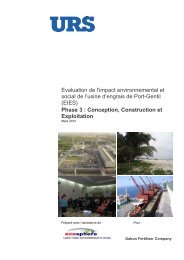En rapport avec le Réseau Interconnecté du Woleu-Ntem - Coface
En rapport avec le Réseau Interconnecté du Woleu-Ntem - Coface
En rapport avec le Réseau Interconnecté du Woleu-Ntem - Coface
You also want an ePaper? Increase the reach of your titles
YUMPU automatically turns print PDFs into web optimized ePapers that Google loves.
Tab<strong>le</strong>au 9: Végétation des marécages sur l'axe Oyem-Bitam<br />
Marécages cordonnées Types de marécage Espèces dominantes<br />
5 N 01°54.838’ Raphia hookeri, Macaranga schweinfurthii,<br />
E011°35.721’ fermé Xylopia rubescens, Mryrianthus arboreus<br />
6 N 02°00.805' Hal<strong>le</strong>a <strong>le</strong>dermannii<br />
E011°30.868' ouvert<br />
Les cultures :<br />
Photo 3: Marécage ouvert à Hal<strong>le</strong>a <strong>le</strong>dermannii<br />
Les principa<strong>le</strong>s cultures observées sur l’axe Oyem-Bitam sont synthétisées<br />
dans <strong>le</strong> tab<strong>le</strong>au suivant. <strong>En</strong> plus des plantations d’hévéa et des cacaoyères,<br />
<strong>le</strong>s autres cultures rencontrées sont <strong>le</strong>s bananiers, <strong>le</strong>s atangatiers, <strong>le</strong>s<br />
manguiers, <strong>le</strong>s avocatiers et <strong>le</strong>s goyaviers qui constituent l’essentiel des<br />
vergers observés sur cet axe.<br />
Photo 4: Plantation d'hévéa (Hevea brasiliensis)<br />
69<br />
EIES – <strong>Réseau</strong> interconnecté <strong>du</strong> Wo<strong>le</strong>u‐<strong>Ntem</strong><br />
Rapport final Novembre 2010






